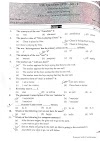Here are some multiple-choice questions for the database management system in Computer Science class 12.
The answers are colored red. Enjoy it😀.
1. DBMS is a collection of ………….. that enables users to create and maintain a database.
A) Keys
B) Translators
C) Program
D) Language Activity
2. In a relational schema, each tuple is divided into fields called
A) Relations
B) Domains
C) Queries
D) All of the above
3. In an ER model, ……………. is described in the database by storing its data.
A) Entity
B) Attribute
C) Relationship
D) Notation
4. DFD stands for
A) Data Flow Document
B) Data File Diagram
C) Data Flow Diagram
D) None of the above
5. A top-to-bottom relationship among the items in a database is established by a
A) Hierarchical schema
B) Network schema
C) Relational Schema
D) All of the above
6. ……………… table stores information about the database or about the system.
A) SQL
B) Nested
C) System
D) None of these
7. …………..defines the structure of a relationship that consists of a fixed set of attribute-domain pairs.
A) Instance
B) Schema
C) Program
D) Super Key
8. ……………… clause is an additional filter that is applied to the result.
A) Select
B) Group-by
C) Having
D) Order by
9. A logical schema
A) is the entire database
B) is a standard way of organizing information into accessible parts.
C) Describes how data is actually stored on a disk.
D) All of the above
10. ………………… is a full form of SQL.
A) Standard query language
B) Sequential query language
C) Structured query language
D) Server-side query language
11) A relational database developer refers to a record as
A. a criteria
B. a relation
C. a tuple
D. an attribute
12) ………. keyword is used to find the number of values in a column.
A. TOTAL
B. COUNT
C. ADD
D. SUM
13) An advantage of the database management approach is
A. data is dependent on programs
B. data redundancy increases
C. data is integrated and can be accessed by multiple programs
D. none of the above
14) The collection of information stored in a database at a particular moment is called as ……
A. schema
B. instance of the database
C. data domain
D. independence
15) Data independence means
A. data is defined separately and not included in programs.
B. programs are not dependent on the physical attributes of data
C. programs are not dependent on the logical attributes of data
D. both B and C
16) A ……… is used to define the overall design of the database
A. schema
B. application program
C. data definition language
D. code
17) Key to representing the relationship between tables is called
A. primary key
B. secondary key
C. foreign key
D. none of the above
18) Grant and revoke are ……. statements.
A. DDL
B. TCL
C. DCL
D. DML
19) DBMS helps achieve
A. Data independence
B. Centralized control of data
C. Neither A nor B
D. Both A and B
20) ………. command can be used to modify a column in a table
A. alter
B. update
C. set
D. create
21) The full form of DDL in Database Management System is
A. Dynamic Data Language
B. Detailed Data Language
C. Data Definition Language
D. Data Derivation Language
22) A ……….. is a set of columns that identifies every row in a table.
A. composite key
B. candidate key
C. foreign key
D. super key
23) A set of possible data values is called
A. attribute
B. degree
C. tuple
D. domain
24) The full form of DDL in Database Management System is
A. Dynamic Data Language
B. Detailed Data Language
C. Data Definition Language
D. Data Derivation Language
25) To change column value in a table the ……… command can be used.
A. create
B. insert
C. alter
D. update
26. Which of the following SQL command can be used to modify existing data in a database table?
A) MODIFY
B) UPDATE
C) CHANGE
D) NEW
27. Which is the subset of SQL commands used to manipulate Oracle Database Structures, including tables?
A) Data Definition Language
B) Data Manipulation Language
C) Data Described Language
D) Data Retrieval Language
28. What are the different events in Triggers?
A) Define, Create
B) Drop, Comment
C) Insert, Update, Delete
D) Select, Commit
29. Some of the utilities of DBMS are ………….
i) Loading ii) Backup iii) File organization iv) Process organization
A) i, ii, and iv only
B) i, ii, and iii only
C) ii, iii, and iv only
D) All i, ii, iii, and iv
4. ………………. first proposed the process of normalization in DBMS.
A) Edgar. W
B) Edgar F. Codd
C) Edward Stephen
D) Edward Codd









0 Comments